Put the takeaway menu down and make the tastiest Singapore Chow Mein (also known as Singapore Noodles) at home in just 30 minutes with this easy recipe. With tasty prawns/shrimp, chicken, soft scrambled eggs, fresh veggies, seasoned with fragrant curry powder, and an umami sauce, these noodles are nutritious, healthy and satisfying.
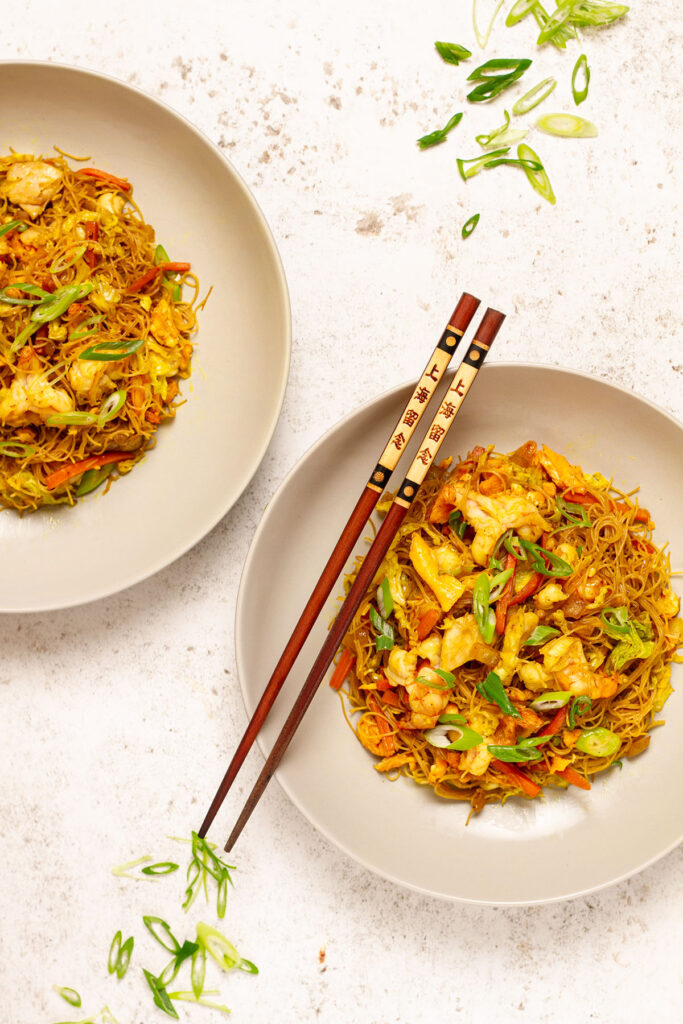
But that's not all - this recipe is also highly adaptable. Whether you prefer mild or spicy flavours, you can easily adjust things to your liking (as well as experimenting with different veggies and proteins).
For all your favourite Singapore Noodle flavours, but with rice instead of noodles, take a look at my Singapore Fried Rice. It's also super easy and quick to put together, and a great way to use leftover rice. Or for more super tasty weeknight-friendly noodle dishes my Teriyaki Salmon Noodles and Duck Stir Fry With Noodles and Hoisin Sauce are sure to hit the spot.
The post contains additional information and helpful tips to ensure the recipe turns out great the first time. Please use the link above to jump to the recipe card at the end if you are in a hurry!
Jump to:
- What is Singapore Chow Mein?
- ✅ 5 reasons why you'll love this recipe:
- 🛒 Ingredients and variations:
- Gluten free Singapore Chow Mein
- 🧑🍳 Recipe steps
- 3. Veggies
- 4. Bring it all together
- 👍 Expert tips
- Variations:
- Serving suggestions
- 🙋 FAQs
- 📦 Storage instructions
- 😋 More noodle recipes to try
- 📖 Recipe
- Singapore Chow Mein
What is Singapore Chow Mein?
Singapore Chow Mein, also known as Singapore Noodles, is a popular Chinese stir-fried noodle dish that features on most Chinese takeaway menus. Despite its name, it is not actually a traditional dish from Singapore. Its origins are unclear, but it is believed to have been created by Chinese immigrants living in Hong Kong or the UK, who were trying to create a dish that would appeal to Western tastes.
The dish typically consists of thin rice vermicelli noodles stir-fried with a variety of vegetables such as onions, cabbage and carrots, and proteins such as shrimp, chicken, or pork and egg. The dish is seasoned with a blend of curry powder and other spices, which gives it a distinctive yellow colour and slightly spicy flavour that distinguishes the dish from more traditional chow mein dishes like Chicken Chow Mein or Special Chow Mein.
✅ 5 reasons why you'll love this recipe:
- Super tasty, nutritious and satisfying - with tasty proteins, lots of veggies with fragrant curry powder with an umami sauce
- Ready in 30 minutes - perfect for a weeknight dinner
- Adaptable - adjust the level of spiciness, experiment with different veggies or use different types of meat or protein
- Better than takeaway - packed with fresh veggies, it's healthier and quicker too
- Perfect for a fridge clear-out - add leftover veggies and meat
🛒 Ingredients and variations:
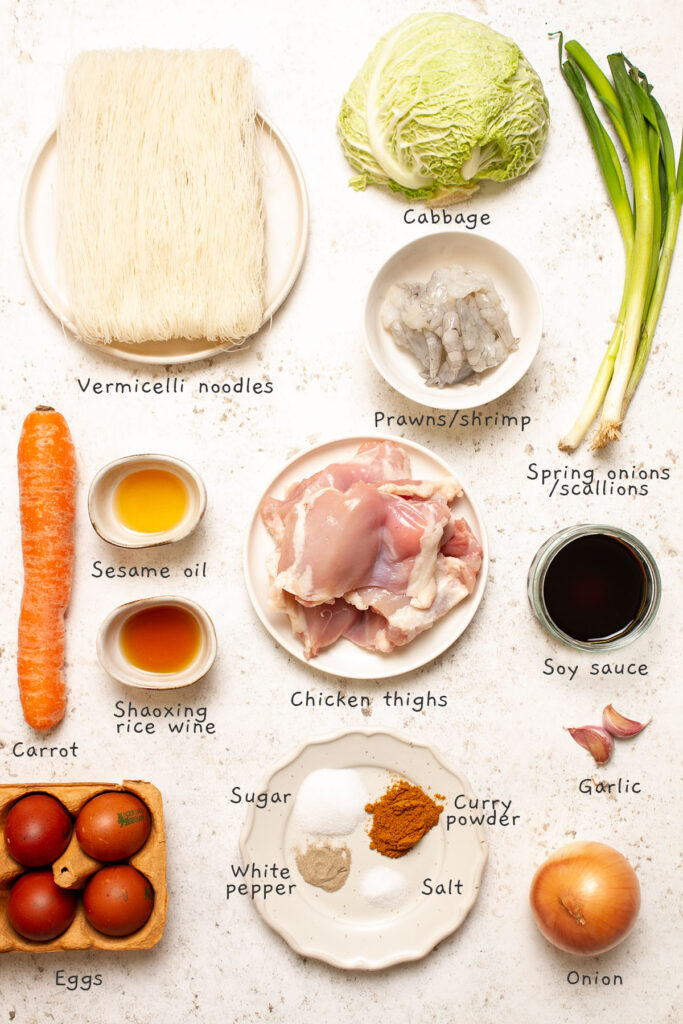
Noodles
Rice vermicelli noodles are the best option, as they are light and absorb flavours well. You should be able to find them in your local supermarket, but in my experience, these aren't as good as some of the ones I've picked up in Asian grocery stores. I particularly like Wai Wai noodles.
You can also try using other types of noodles, such as wheat noodles or egg noodles, if you prefer a different texture or flavour. Just keep in mind that the taste and texture may be a little different to what you might be expecting.
Proteins
The main proteins you'll find in Singapore Chow Mein are prawns, Chinese BBQ Pork (Char Siu) and egg. Char Siu takes 90 minutes to make plus 2 days of marinading so unless you have some leftovers available you'll probably want an alternative. I tend to use chicken thighs. You can use pork chops or rotisserie chicken. Ground meat is also an option although when I tested with ground pork I found it faded into the dish and didn't add a lot.
You can also skip some of the proteins if you prefer and increase the veggies. To make the dish vegetarian, simply replace the pork and prawns with more eggs and veggies. For vegan Singapore noodles, you can omit the egg as well as add more veggies or tofu.
Veggies
I like to add cabbage for extra umami flavour and crunch, carrot sticks for a little sweetness, and onion and spring onions. That said there are lots of options here so feel free to switch things up or use what you have available. This recipe is perfect for a fridge clear-out. Other options that will work well include courgette/zucchini, bell peppers and bean sprouts.
The best curry powder
A mix of curry powder, sugar, salt and white pepper gives the dish a distinctive flavour that sets it apart from other fried rice dishes.
Curry powder is the main ingredient in the spice mix, so you might be wondering which one to choose. A good curry powder will make all the difference. S&B curry powder is one of my favourites but another quality curry powder will work well. When it comes to spice level, feel free to choose mild, medium or hot based on your preference.
Sauce
My Singapore Noodle sauce is made from soy sauce, sesame oil and Shaoxing wine. You can swap the Shaoxing wine for Sake, dry sherry white wine or chicken stock for an alcohol-free option.
Gluten free Singapore Chow Mein
Rice vermicelli noodles are gluten-free, but please ensure you check the label or ask the manufacturer to ensure that there are no cross-contamination issues with gluten during the manufacturing process.
Soy sauce is the only other ingredient that contains gluten in this recipe. You can switch it for the same amount of tamari.
🧑🍳 Recipe steps
1. Noodles, sauce and spice mix
Cook the noodles according to packet instructions, drain, run under cold water and set aside. Mix the curry powder, chicken stock powder, sugar and white pepper in a small bowl and set aside. Then make the sauce by mixing the soy sauce, sesame oil and Shaoxing wine in another small bowl.
How to cook rice vermicelli: cooking the noodles is super simple and normally involves placing the noodles in a large Pyrex bowl or pan, pouring on some boiled water and leaving for 3-5 minutes until the noodles are almost done but still a little hard. That said cooking instructions can vary depending on the brand so make sure you check the packet first.
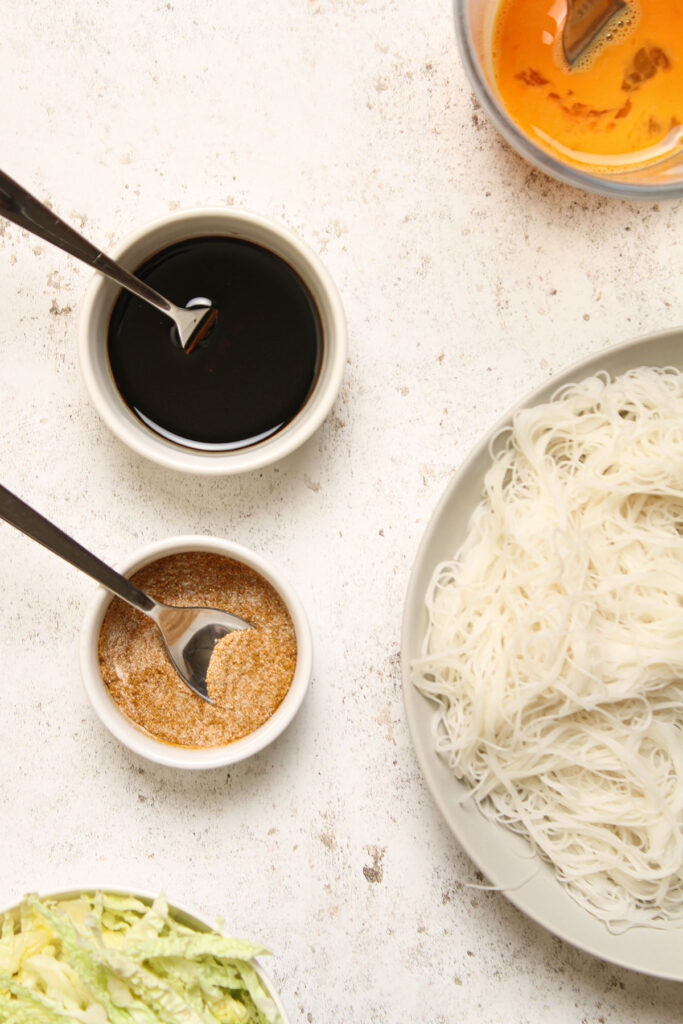
2. Cook the proteins
Place a pan on a medium heat, add a little oil and add the eggs. When they start to set scramble them into small pieces using chopsticks or a spatula and set them aside. Increase the heat of the pan and add the chicken and fry until brown. Then add the prawns/shrimp and cook for a minute or two more until opaque.
How to prepare the prawns/shrimp: prawns look and taste better when you butterfly them first. This simply means cutting each one open along the back and removing the dark vein. This allows them to cook more evenly and cleans them by removing their unappealing digestive tract. You can skip this part if you are pushed for time and the prawns will still taste okay, but it's worth the extra effort.
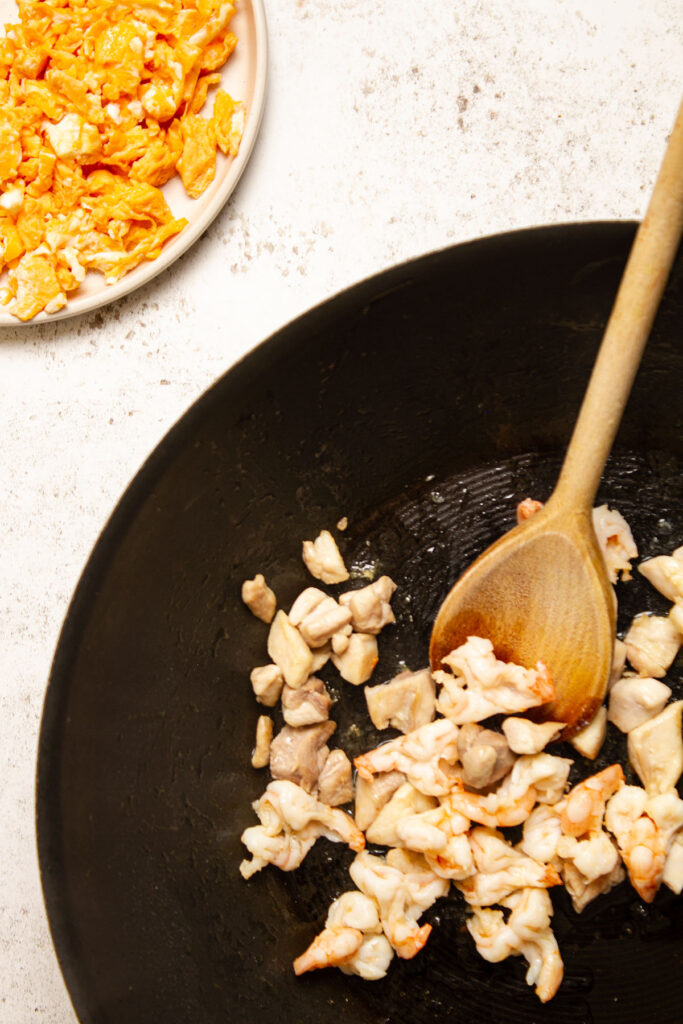
3. Veggies
Add a little more oil to the pan if necessary, add the onions and fry for a few minutes until translucent. Then fry the white parts of the spring onion/scallions, carrot and cabbage for a few minutes until tender. Reduce the heat to medium, add the garlic and cook for one more minute until fragrant. Then stir in the spice mix.
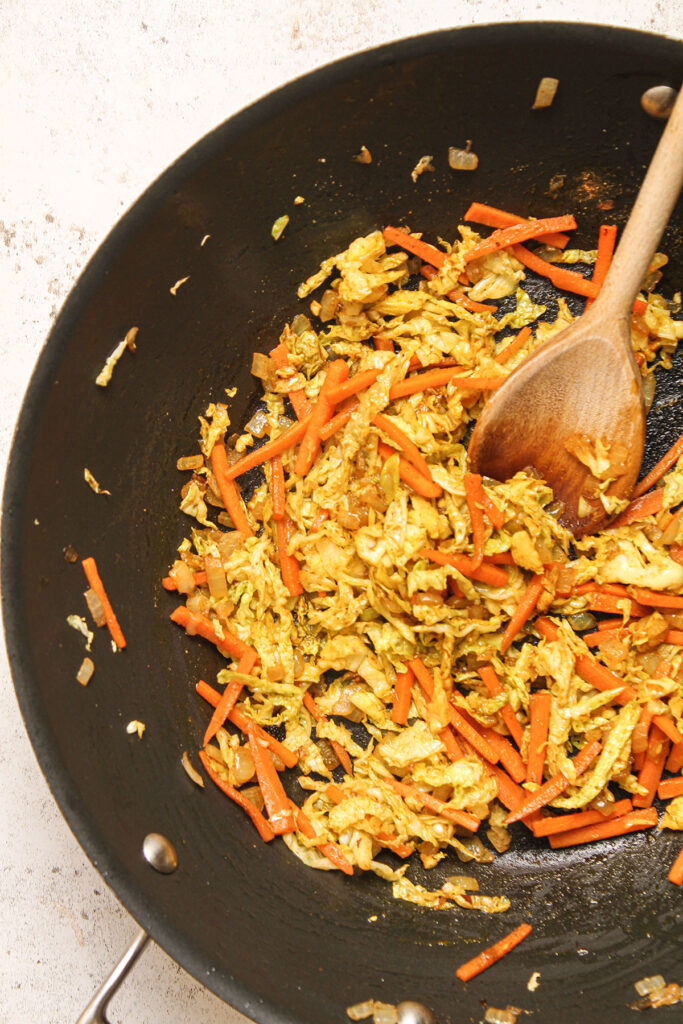
4. Bring it all together
Add the cooked noodles to the pan and toss until hot. Pour on the sauce and add the cooked chicken, prawns and egg and toss everything together for 2-3 minutes until the ingredients are hot and mixed well. Serve immediately, topped with the green parts of the spring onions/scallions.
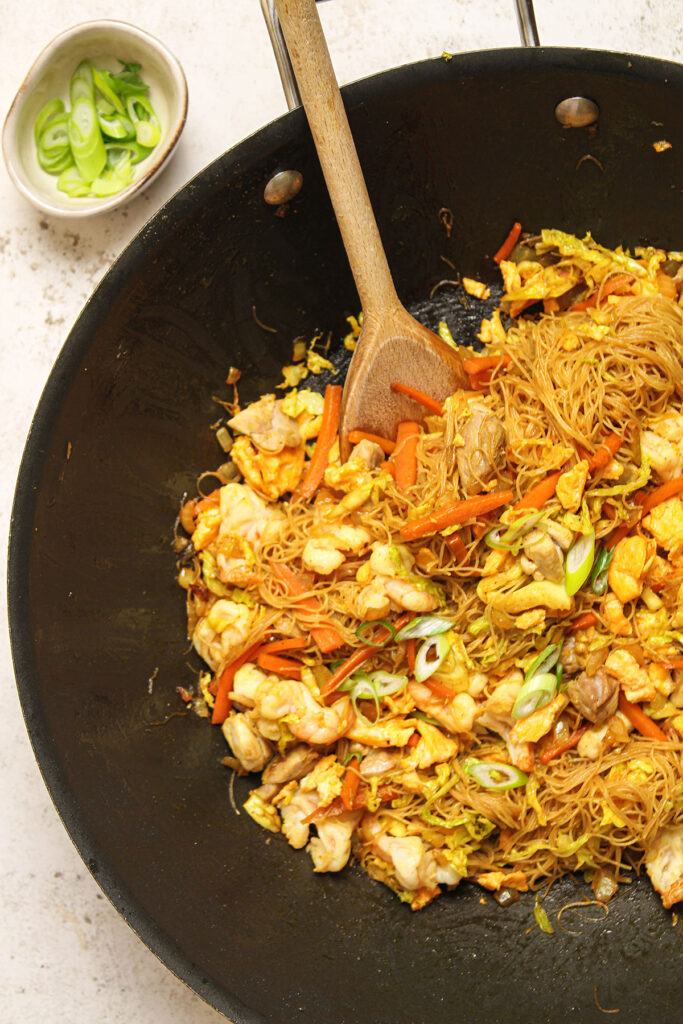
👍 Expert tips
- Prep the ingredients beforehand - Things will move quickly once you start stir-frying so make sure you have all ingredients, chopped and laid out before you start cooking.
- Undercook the noodles a little - to get the perfect consistency, slightly undercook the noodles. Remember that they will cook further during the stir-fry process.
- Use a wok - It allows you to toss everything together quickly at a high heat. If you don't have one use a large frying pan with high sides.
Variations:
As previously mentioned, Singapore Chow Mein is a flexible recipe that can be adapted to suit your tastes.
- Vegetarian - Substitute meat with tofu, mushrooms, or any vegetables of your choice.
- Spicy - Use extra chilli paste, chilli flakes or fresh chilli peppers to add a spicy kick.
- Seafood - Include shrimp, squid or crab meat to give it a seafood flavour.
- Pork - replace the chicken with pieces of pork fillet, loin or leg.
- Beef - swap the chicken with beef. Sirloin, flank steak or rump all work well.
- Peanut - Mix in some peanut butter into the sauce for a creamy, nutty flavour.
- Char - Add Char Siu (Chinese barbecued pork) for a sweet and savoury taste.
- Tangy - Add lemongrass, lime juice or vinegar to the sauce.
Serving suggestions
Packed with protein, fresh veggies and tasty spicy and umami flavour Singapore Noodles can certainly be considered a stand-alone meal. It can also be served alongside other Chinese takeaway-inspired dishes like Chinese Chicken and Sweetcorn Soup, Salt and Chilli Chicken or Crispy Shredded Chilli Beef.
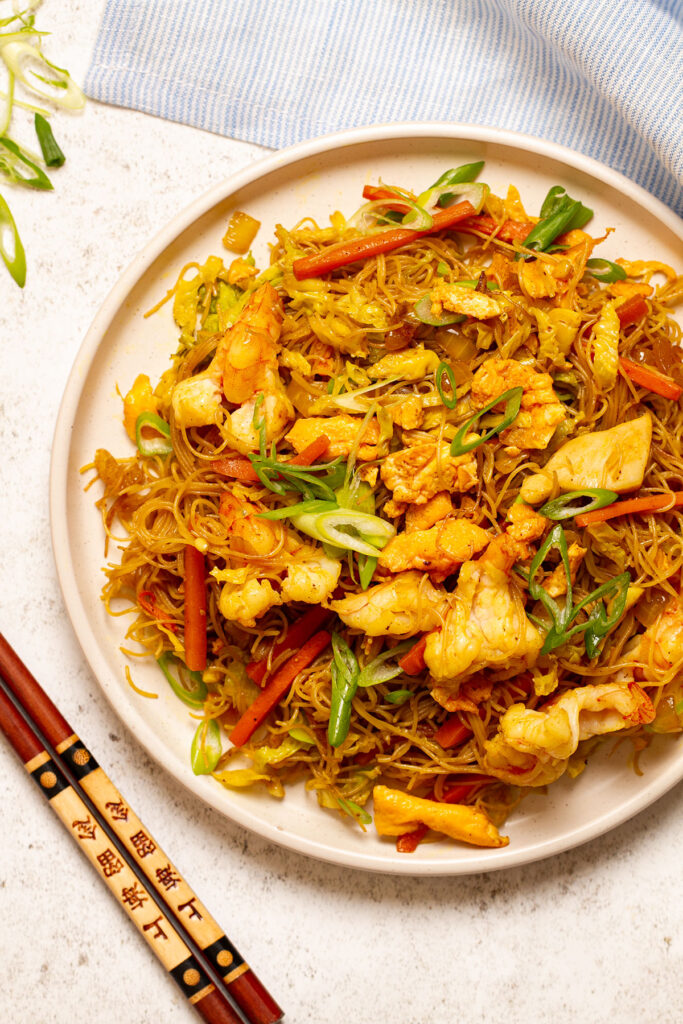
🙋 FAQs
Authentic Singapore Chow Mein (Hokkien Mee) is a popular street food in Singapore made with thin yellow noodles, rice vermicelli, seafood, meat, vegetables, and soy sauce-based sauce. Westernized Singapore Noodles were created outside of Singapore and are a popular Chinese takeaway option in Western countries. The key ingredients are rice vermicelli, curry powder, vegetables, meat or shrimp, and sometimes scrambled eggs.
Singapore Noodles, also known as Singapore Mei Fun, can be spicy depending on the recipe. The level of spiciness can vary depending on the amount and type of curry powder used and whether other spicy ingredients are added. If you are sensitive to spice, you can use a mild curry powder and skip the fresh chilli or chilli powder.
Feeding a crowd? You can double or triple the ingredients in the recipe by using the scaling buttons on the top right-hand side of the recipe card.
A wok is ideal for stir-fry dishes like Singapore Chow Mein because its high sides allow you to toss everything together quickly on a high heat, it is not essential and another large frying pan with high sides will also do the job.
The dishes have different origins, noodle types, flavours, and ingredients. Chow Mein is a Chinese dish with stir-fried egg noodles, veggies, and meat, seasoned with soy sauce. Singapore Noodles, is made with rice vermicelli, curry powder, veggies, and meat or seafood, giving it a slightly spicy flavour.
📦 Storage instructions
Singapore Chow Mein tastes best when served straight from the wok, but it can be stored in the fridge for up to 3 days. Refrigerate as soon as it is cool after covering with plastic wrap or placing in an airtight container. Make sure you reheat it thoroughly on the stove or in the microwave.
I haven't attempted to freeze Singapore Noodles, and wouldn't recommend it because it's likely to alter the texture of the egg and vermicelli.
😋 More noodle recipes to try
Noodle recipes are versatile, quick, and easy to prepare, making them a convenient meal option for busy weeknights. If you enjoyed this recipe you should check out my other noodle dishes.
Did you try this recipe? It would be really great if you could leave a comment and a star rating ⭐️. I would love to receive your feedback and know that other readers find it helpful too.
Don't forget to tag #knifeandsoulrecipes on Instagram or @knifeandsoul on Pinterest!
📖 Recipe
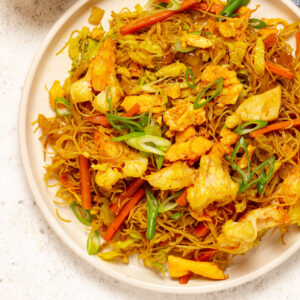
Singapore Chow Mein
Equipment
Ingredients
Spice Mix
- ½ tsp salt
- ½ tsp white pepper
- 1 tbsp curry powder (Note 1)
- 4 tsp sugar
Sauce
- 5 tbsp soy sauce (Note 2)
- 2.5 tbsp Shaoxing rice wine (Note 3)
- 4 tsp sesame oil
Remaining ingredients
- 200g (7 oz) rice vermicelli noodles (Note 4)
- 3 tbsp neutral oil (Note 5)
- 2 large chicken thighs (Note 6)
- 200 g (7 oz) prawns/shrimp peeled and deveined
- 1 onion finely chopped
- 2 spring onions / scallions finely chopped with green parts and white parts separated
- 240 g (8 oz) cabbage finely shredded
- 1 large carrot cut into matchsticks
- 2 cloves garlic crushed
- 4 eggs beaten
Instructions
- Cook the noodles according to packet instructions, run under cold water and set aside. The noodles should be a little underdone, as the stir frying process will cook them further. (Note 4)
- Combine the spice mix ingredients in a small bowl.
- Mix the sauce ingredients in another small bowl.
- Place a wok or large frying pan on a medium to high heat and ½ tbsp of the oil.
- Add the egg when the oil is hot. Wait a few seconds for it to begin to cook, scramble using chopsticks or a spatula and remove from the pan and set aside.
- Increase the heat of the pan, pour in half of the remaining oil, add the chicken pieces and fry for a few minutes until lightly browned.
- Add the prawns/shrimp and cook for another 1-2 minutes until opaque. Then remove from the pan and set aside. (Note 7)
- Increase the heat of the pan, add the remaining oil and add the onions and cook for a few minutes until translucent.
- Add the white parts of the spring onions/scallions, carrot and cabbage to the pan and cook for a few minutes until tender.
- Reduce the heat of the pan to medium, add the garlic and cook for 1 minute until fragrant. Then stir in the spice mix.
- Add the noodles and toss until they become hot.
- Pour on the sauce, add the cooked chicken, prawns/shrimp and scrambled egg and toss everything together.
- Serve immediately, topped with the green parts of the spring onions/scallions.
Notes
- Curry powder: Any brand of generic curry powder is fine. I use medium but hot is also fine if you like spice.
- Soy sauce: Use light or all-purpose soy sauce. Avoid dark because it will make the flavour too intense.
- Shaoxing rice wine: substitute with dry sherry, cooking sake, Mirin or chicken stock.
- Noodles: Rice vermicelli are recommended but you can also try using other types of noodles, such as wheat noodles or egg noodles, if you prefer a different texture or flavour. Cooking vermicelli noodles normally involves placing the noodles in a large Pyrex bowl or pan, pouring on some boiled water and leaving for 3-5 minutes until the noodles are almost done but still a little hard. Cooking instructions can vary depending on the brand so make sure you check the packet first.
- Oil: Choose an oil with a high burn point. Neutral oils like sunflower, vegetable or ground nut oil will all work well. Do not use olive oil.
- Chicken: Equivalent to (200g or 6oz). I use thighs because they are juicier and more succulent than breast but you can also use breast or add leftover cooked chicken. Chicken is cooked when it is white in the centre.
- How to tell if prawns /shrimp are cooked: raw prawns/shrimp are translucent and turn pink and opaque when cooked. Remove them from the pan when they become opaque to avoid overcooking them.


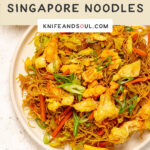

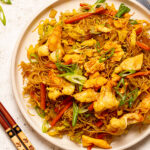
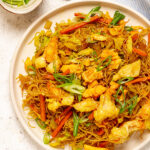

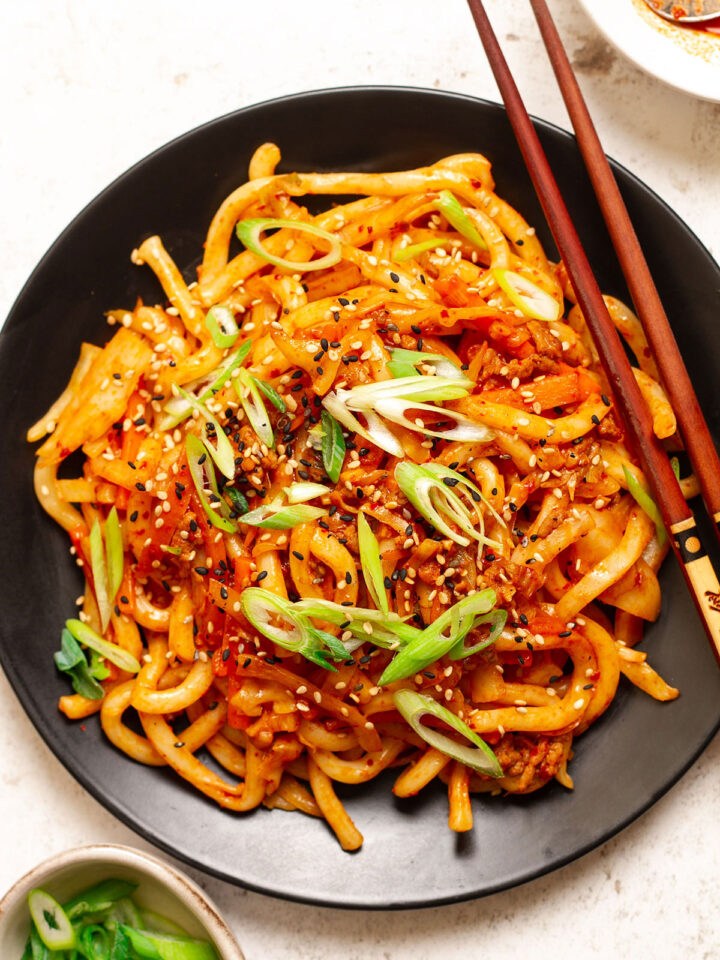
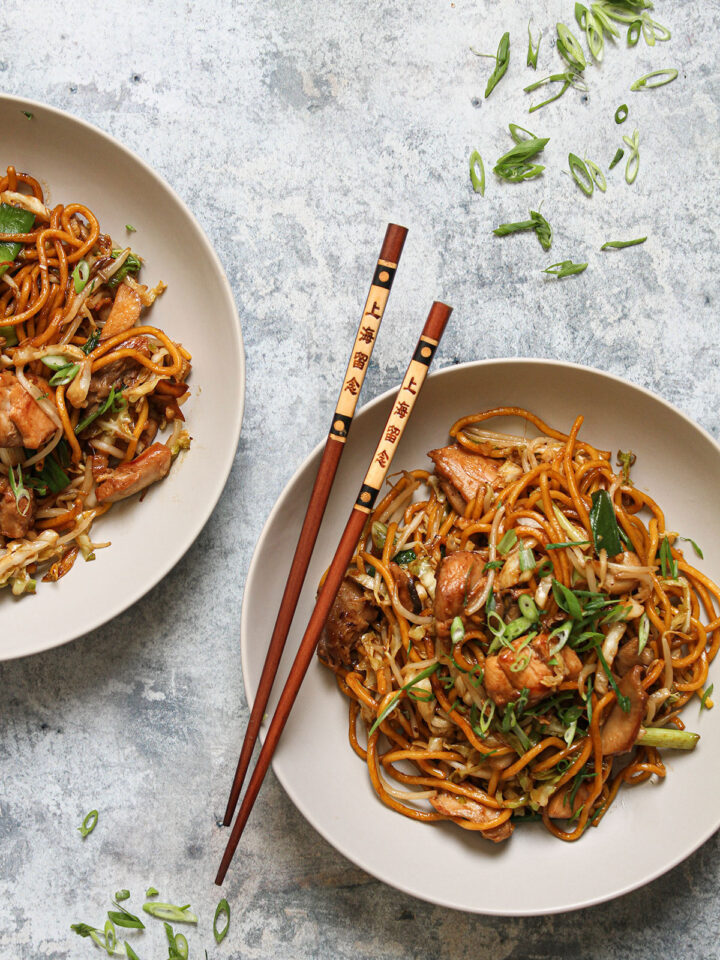
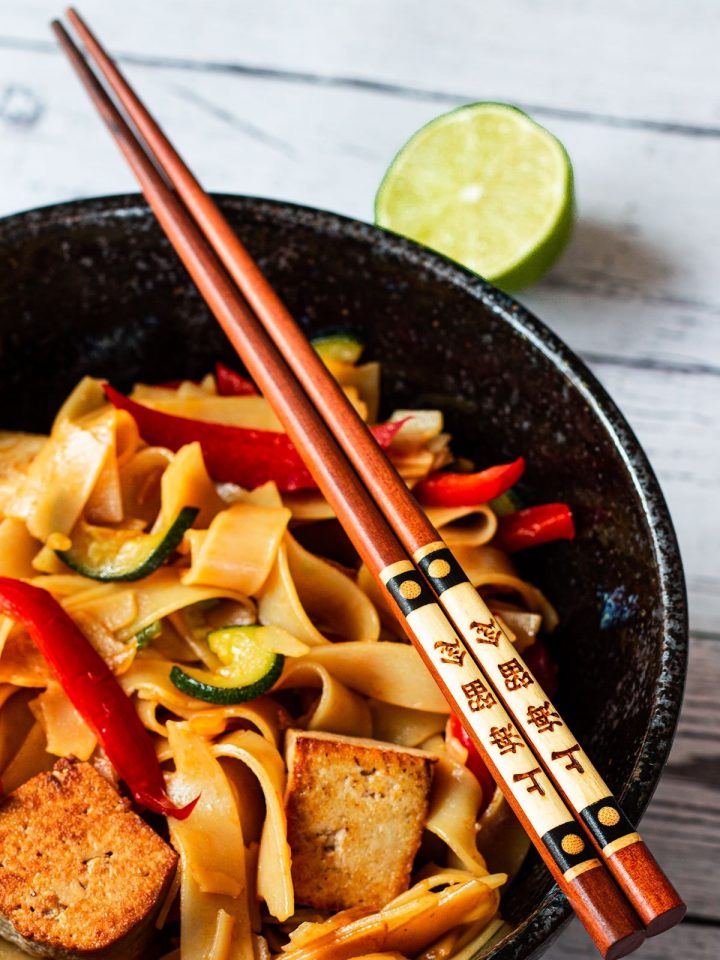
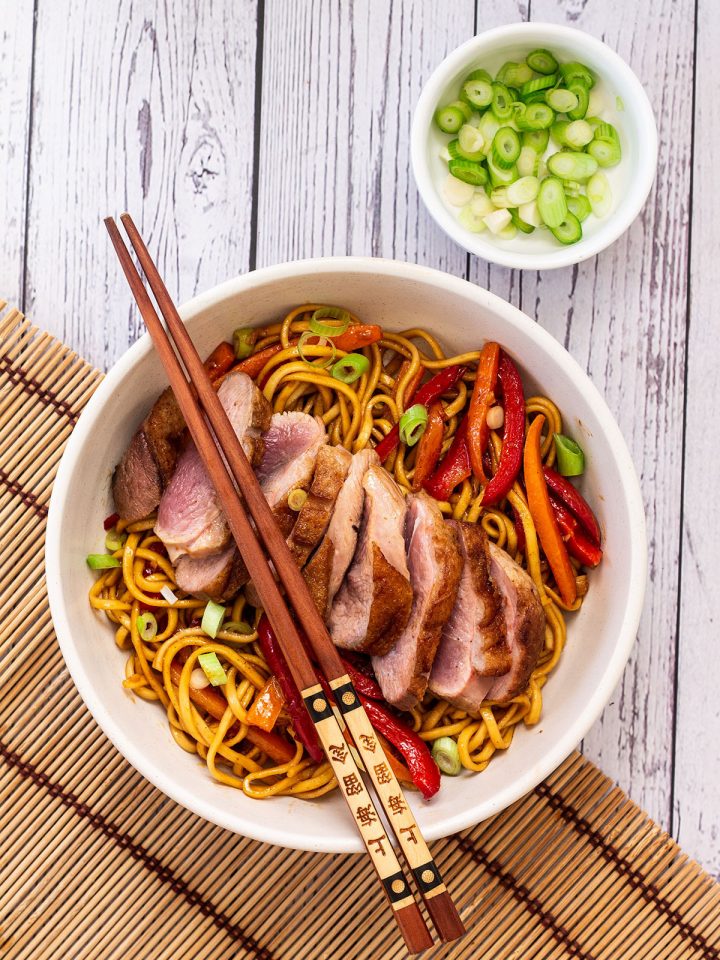
A delicious recipe with so many flavours. I will certainly be cooking it again. I made half the quantity for two persons and used ready cooked prawns to save time.
Thanks for commenting, Angela. Really glad you enjoyed it.